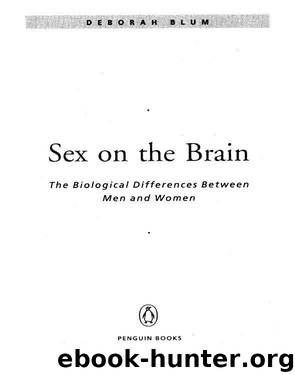Sex on the Brain by Deborah Blum

Author:Deborah Blum
Language: eng
Format: epub, mobi
Publisher: Penguin Group US
Chapter Six
THE BIG T
Defining Testosterone
Once upon a time—okay, until about 50 years ago—scientists thought the male body contained a kind of biological magic. Specifically, they thought that the testes produced a substance that was all masculine and all-powerful.
We know now they were dreaming of testosterone. And some undoubtedly continue to do so, despite the fact that the hormone has turned out to be neither of those things.
Testosterone’s reputation stood highest, in a sense, before people actually knew what it was. Biologists of those earlier days, mostly men, imagined a material of pure wonder. And they went to real extremes to find it. They analyzed gallons of urine. They ground up animal parts. One leading French scientist of the nineteenth century sought to prove the existence and potency of this magical male stuff by injecting himself with pureed dog testes. He insisted that the extract boosted his energy and sex drive and enabled him to pee in a higher arc, a major issue for men, obviously, in contrast to women.
In the 1920s, physicians grafted monkey testes onto aging men, trying to restore their virility. They literally had to turn away volunteers. And still other doctors used ground-up goat testes to treat people troubled by everything from epilepsy to depression. Then, in the ‘30s, a group of German researchers distilled 25,000 liters of policemen’s urine, looking for the primary male hormone. How unfair, after such effort, that they didn’t find it. They did, however, find another androgen, a related hormone called androsterone. That discovery reassured biologists that the approach itself was solid, that perseverance would bring success.
The German team next mashed up some 2,000 pounds of bull testicles. While they were still analyzing the results, they were beaten to the grail by another team of European scientists. In a classic example of big not always being better, the steroid hormone testosterone was isolated from the testes of mice (although it’s not clear how many pounds it took). Dutch scientists published those results in 1935, along with a description of testosterone’s crystalline structure. Later that year, German biologist Adolf Butenandt, who had unsuccessfully pursued the hormone through policemen’s urine and bull testicles, reported on the successful synthesis of the hormone. There are many scientific discoveries that go unheralded. This was not one of them.
Physicians hailed it as “medical dynamite,” the test-tube birth of “sexual TNT.” Four years later, Butenandt received the Nobel Prize for his work in demystifying testosterone, especially for showing the world how to make it in the laboratory. Since that time, researchers have become so comfortable with testosterone, they rarely even call it by its full name. Among scientists, testosterone often is simply referred to as the letter T, capitalized of course. The big T.
The discovery stripped away the hormone’s mystique; it was no longer an unknown source of unlimited power. As Butenandt and his Nobel cowinner, Leopold Ruzicka, demonstrated, testosterone is nothing extraordinary in terms of life chemistry. It’s a cholesterol derivative. The basic structure is a chunky package of carbon rings, four in all, with some tag-along oxygen and hydrogen gripping the edges.
Download
This site does not store any files on its server. We only index and link to content provided by other sites. Please contact the content providers to delete copyright contents if any and email us, we'll remove relevant links or contents immediately.
Sapiens: A Brief History of Humankind by Yuval Noah Harari(14248)
The Tidewater Tales by John Barth(12608)
Mastermind: How to Think Like Sherlock Holmes by Maria Konnikova(7225)
Do No Harm Stories of Life, Death and Brain Surgery by Henry Marsh(6887)
The Thirst by Nesbo Jo(6826)
Why We Sleep: Unlocking the Power of Sleep and Dreams by Matthew Walker(6618)
Life 3.0: Being Human in the Age of Artificial Intelligence by Tegmark Max(5474)
Sapiens by Yuval Noah Harari(5293)
The Longevity Diet by Valter Longo(5018)
The Body: A Guide for Occupants by Bill Bryson(4974)
The Rules Do Not Apply by Ariel Levy(4856)
The Immortal Life of Henrietta Lacks by Rebecca Skloot(4525)
Animal Frequency by Melissa Alvarez(4394)
Why We Sleep by Matthew Walker(4359)
The Hacking of the American Mind by Robert H. Lustig(4318)
Yoga Anatomy by Kaminoff Leslie(4303)
All Creatures Great and Small by James Herriot(4231)
Double Down (Diary of a Wimpy Kid Book 11) by Jeff Kinney(4206)
Barron's AP Biology by Goldberg M.S. Deborah T(4096)
